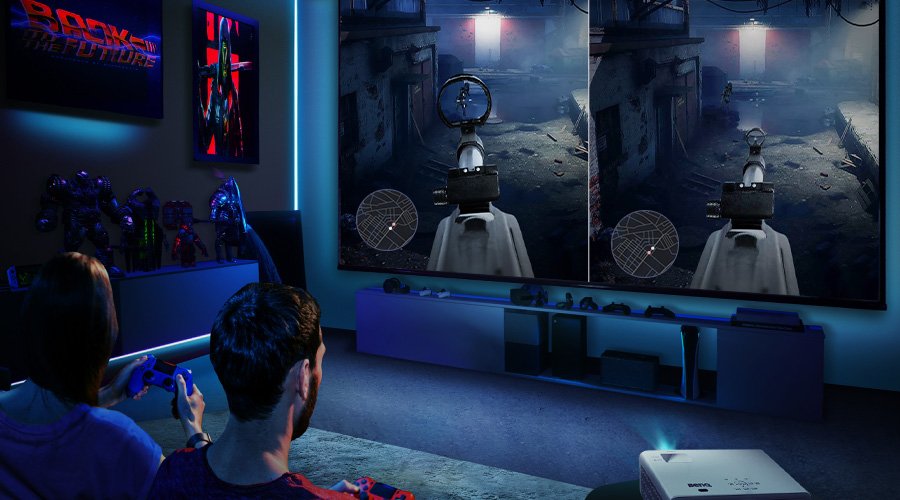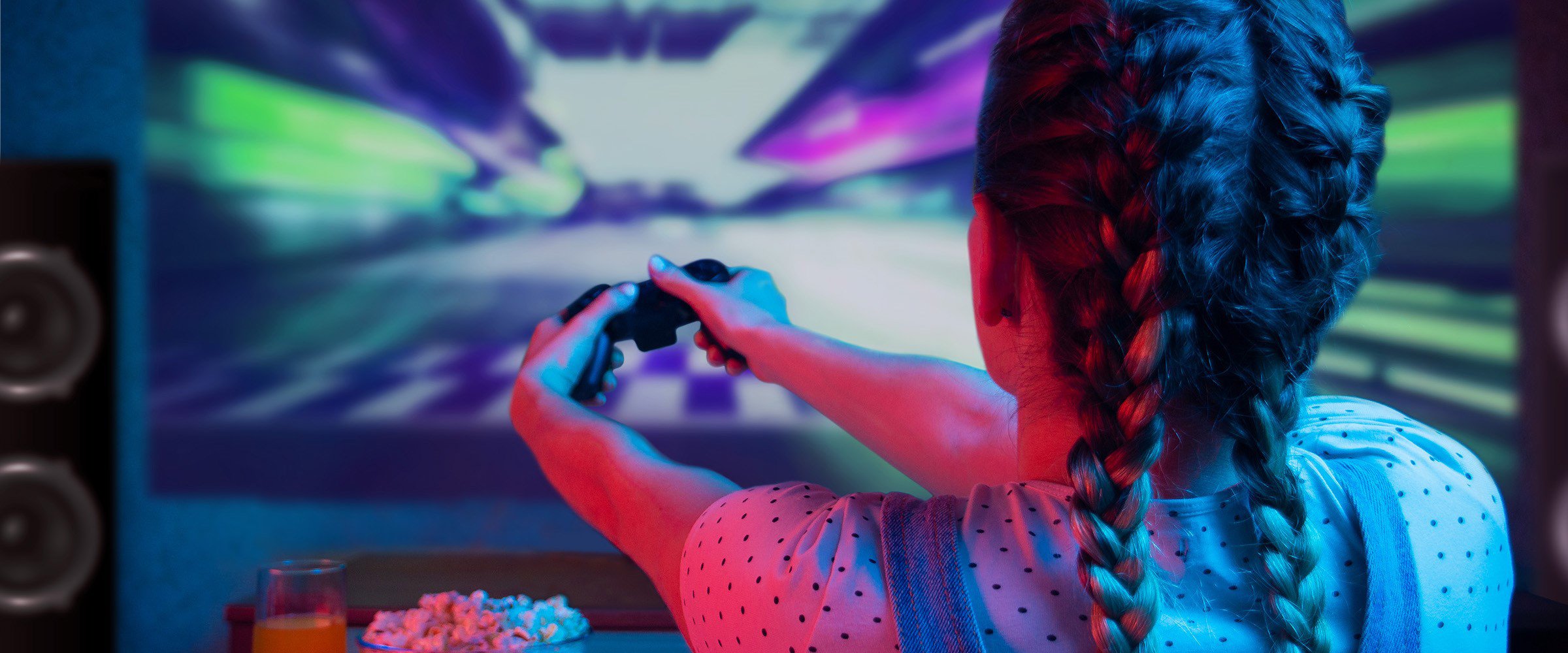Are you looking to upgrade your movie nights with the best audio experience possible? Look no further!
This guide will help you maximize your audio experience by giving you a step-by-step tutorial on how to connect a soundbar to projector for an ultimate cinematic experience. You won’t want to miss out on this!
The introduction of home theater projectors has made it possible to enjoy movies and television shows on a large scale at home. To make the experience more immersive, many people are now turning to soundbars. Connecting a soundbar to your projector can significantly boost audio quality and allow you to hear more of the subtle audio cues that your favorite movies and shows were designed with.
However, while there are many different types of soundbars available and several ways that you can connect one to your projector, understanding which ones are best and how they all work together may seem daunting for some. In this guide, we will explore the different types of connectivity available for connecting soundbars to projectors as well as provide a step-by-step tutorial on connecting one. After reading this guide, you should have all the information you need to connect a soundbar to your home theater projector for an immersive auditory experience that rivals even professional cinemas!
Understanding Soundbars and Projectors
To boost audio quality for viewing movies or playing games on projectors, soundbars are a great choice. However, before beginning the process of connecting your soundbar to your projector, it’s essential to understand the basics of both devices.
A soundbar is a device that includes one or multiple built-in speakers and can be connected to TVs, media players and other sources in order to provide enhanced audio quality compared to what the TV or other source can provide.
A projector is an electronic device used to project video or images onto a viewing surface like walls and screens. With projectors, you can significantly enlarge the size of the video or images you’re viewing. Besides offering clearer images with a more defined level of detail than traditional displays, they also offer more flexibility in terms of installation options because they don’t need much space around them to be usable. Generally speaking, most projectors come with basic built-in speakers that aren’t ideal if you want great sound quality for movies or gaming sessions.

Different projector models
When connecting soundbars to projectors, it is important to understand that different projector models will require various cables and attachment processes. Before purchasing a soundbar, make sure that the model you choose is compatible with your projector. This can be verified by reviewing the technical specifications of both devices or consulting with the manufacturer. Below are some common projector models and their respective soundbar connection methods:
DLP Projectors – DLP projectors tend to use either HDMI or 3.5mm audio cables for audio transmission. Most DLP models feature an audio out port that may accept a 3.5mm cable, allowing for easy connection to a dedicated home theater system such as a soundbar or surround system.
LCD Projectors – LCD projectors generally require either composite video or HDMI connection for audio transmission. While most LCD units have 3.5mm ports for outputting stereo audio, it is best to opt for either composite video or HDMI as this will guarantee full compatibility with the chosen soundbar system and provide better overall picture quality and sound clarity.
LED Projectors – As with DLPs, LED projectors commonly accept either HDMIs or 3.5mm cables as inputs; however, some LED-based models may also feature an SPDIF optical output port that allows users to take advantage of Dolby Digital surround technologies when connected to compatible AV receivers or preamps/processors like those found on higher-end home theaters systems/soundbars.
Technical specifications to look out for
Before connecting your soundbar to your projector, you need to check the technical specifications of the two devices.
It is important to ensure that the soundbar supports the video signal from your projector and provides enough amplification for the area you are training. If your soundbar does not support the video signal from your projector, certain functions may not work properly.
The soundbar should be compatible with at least one of three high-definition audio formats: Dolby Digital, S/PDIF (Sony/Philips Digital Interface Format), and DTS (Digital Theater System). It should also have low latency features such as HDMI CEC (Consumer Electronics Control) to reduce the time it takes for audio and video to sync. Additionally, look for adequate power output, amplifier parameters like frequency response, crossover frequency and gain settings as well as compatibility with wireless audio options like Bluetooth or Wi-Fi.
Connecting Soundbars to Projectors
When connecting soundbars to projectors, there are two main types of cables that you need: an audio cable and a video cable. Depending on the projector you’re using, you may also need a separate power adapter or wall outlet connection.
The most common type of audio connection is a 3.5mm line-in or analog stereo mini-jack on the projector and soundbar. To use this connector, simply connect one end of the 3.5mm cable to the audio-out port on the soundbar and then connect the other end of the cable to the audio-in port on your projector. If your soundbar does not have a 3.5mm jack, you may be able to find an adapter that lets you use an RCA audio connection instead.
You can also use digital audio connections like Toslink or S/PDIF if both your soundbar and projector support it. The Toslink connection is usually represented by a small oval connector while RCA connectors have red/white plugs for left/right channels respectively. Again, double check your equipment specifications as this varies from model to model; some require special cables for digital connections even when connecting with short distances between them (less than 8 meters).
Video connections used for connecting projectors and soundbars vary greatly depending on what kind of video inputs/outputs both devices have — such as DVI, HDMI, composite etcetera — but generally exist in one of three possible configurations: HDMI loop through (which allows both devices to be connected in a single loop), VGA pass through (connecting both devices via VGA ports) or Separate source/displays (using two different cords to each device). You can consult your equipment manuals for more information about specific models’ compatibility with these types of video connectivity options before attempting any complicated setups.
Step-by-step instructions for connecting via HDMI
In order to use your soundbar with a projector to enjoy an enhanced audio experience, it must first be connected properly. There are three options available for connecting a soundbar to a projector: analog, HDMI (HDCP compliant) and mini-HDMI (Type C). The easiest connection is via HDMI, so the following step-by-step instructions will explain how to make this type of connection:
- Locate the HDMI input on the projector and plug in one end of the HDMI cable that came with the soundbar. Connect it securely and put it in position on both devices.
- Locate the other end of the HDMI cable and plug it into one of two ports on the rear of your soundbar. Make sure that you select ‘HDMI Input’ from the source menu when you turn on your device.
- Play content from your device by changing settings if necessary for audio output, or make sure that you have connected an external device correctly, like an Apple TV or Firestick.
- Turn up or down your volume as needed in both devices so that they are balanced correctly – then enjoy superior surround sound quality!
Connection via optical cable
Connecting your soundbar to your projector with an optical cable is a simple and straightforward solution. Begin by identifying the digital audio output port of your projector and then connect one end of the optical cable to it.
Next, connect the other end of the optical cable to an Optical-in on your soundbar. You may have more than one and it may be labeled as Digital Audio IN or simply Optical.
Further, press the appropriate Input button on your soundbar remote control, commonly labeled as Television or TV/CBL, to activate the Optical connection.
Once completed, you can enjoy clear and powerful surround sound from your projector!
Connecting via Bluetooth or Wi-Fi
For those wanting to enjoy the convenience of wireless soundbars, connecting the soundbar to the projector via Bluetooth or Wi-Fi is an ideal solution. Modern soundbars typically come equipped with either Bluetooth or Wi-Fi, so you’ll first want to check for compatibility with your projector. Once you’ve determined that you have successfully connected both items wirelessly, you should be able to start enjoying a better audio experience from your projector without having to run extra cables.
When connecting via Bluetooth or Wi-Fi, some projectors may need a compatible dongle device in order to establish and maintain the connection. Additionally, keep in mind that longer distances may require a stronger transmission and usually require different dongles specific for bigger distances between the projector and soundbar. Though this method is extremely convenient, it can be tricky and expensive due to third Party accessories needed for proper setup.
Adjusting Audio Settings
To get the most out of your projector’s audio experience, be sure to adjust the settings to suit your soundbar. Start by adjusting the volume, as some projectors require it to be adjusted separately from the rest of the audio settings.
Next, make sure your soundbar is set to output in Dolby Digital or surround sound. This setting can typically be found in your projector’s menus and will allow you to experience full surround sound with your projector. Additionally, set your speakers up in a 5-point surround setup if possible – this will provide more accurate and immersive sound.
You should also modify any other audio settings on your projector such as equalizer levels for bass/treble and soundscape mode. Most projectors have preset options for these or you can customize them manually depending on personal preference. Finally, it is important to remember that different makes of projectors may respond differently to audio settings so always double check before committing them permanently!
Configuring the soundbar settings for optimal sound quality
Depending on the type of projector and soundbar you have, configuring the settings may involve different steps. Here are some of the most common configuration steps for soundbars:
- Speaker Configuration: For optimal speaker configuration, ensure you select the correct setting for each input you’ll be using (e.g., HDMI, optical digital audio). Most soundbars come with a few preset configurations such as: stereo, 2 speaker surround sound and 5 speakers. If your soundbar includes Dolby Atmos or other surround sound technology, consult your user manual for specific instructions on how to configure it properly.
- Equalizer Settings: Many current-generation soundbars offer adjustable equalizer settings that allow you to fine-tune the audio output to your liking. You can adjust bass and treble levels separately or take advantage of preset types of music such as pop, rock and classical. Adjusting these outputs appropriately can go a long way towards delivering an immersive audio experience from your projector and soundbar system!
- Volume Level Controls: When connecting your projector and soundbar system, it’s important to ensure that all devices are set at the same volume level in order for them to work together harmoniously. Additionally, keep in mind that some projectors may have their own independent volume controls which may need to be adjusted separately from those controls on the actual device itself!
Using the projector’s audio settings
Most projectors are equipped with audio settings that allow you to configure various sound preferences and features. Depending on your model and brand, the settings may include a Bass Boost, Treble Boost, Volume Controls, Surround Sound Settings, and more.
These settings allow you to fine tune the sound of your projector until it meets your needs. To access these settings, you’ll need to access the projector’s menus on either its remote control or by plugging in a keyboard directly into its USB port. Once you’re in the audio menu tab, you’ll be able to adjust its various sound options.
One common option is a volume setting for hooking up external speakers like soundbars either via bluetooth technology or a 3.5mm jack from the projector’s output socket (e.g., via an RCA adapter). You’ll want to make sure that this is switched on so that the projector’s audio output can reach your connected speakers properly for enhanced sound experience.
Testing and fine-tuning the audio output
After connecting the projector and soundbar, it’s time to test and fine-tune the audio output. Usually, soundbars are pre-configured for various audio formats, but depending on which projector you use, you may need to adjust certain settings.
First, turn on the soundbar to check its initial settings. If necessary, change the connection settings from HDMI to line-in using the menu or a remote control. Then, adjust the audio levels and test out each input mode until you find one that fully displays your projector’s audio capabilities.
Depending on your projector model and brand, there may be different audio inputs available like composite or VGA connectors. If these exist for your device, you’ll want to evaluate both ports before deciding which one works best for your setup. Additionally, if your soundbar is equipped with an automated equalizer or subwoofer feature it can help you get a cleaner sound from different sources such as DVD players or streaming devices.
Once all of these components are connected and adjusted properly make sure to check out all of the extra features that come with your particular soundbar setup like Bluetooth connectivity for wireless music streaming or digital optical inputs for enhanced clarity and quality of speakers.. By taking a few minutes to adjust everything appropriately you can create optimal listening experiences in every viewing environment!
Conclusion
To conclude, connecting a soundbar to your projector can provide an immersive and enjoyable audio experience. It’s important to choose the right soundbar for your projector and ensure that all of your connection points are compatible.
Be sure to consider the size of your room as well as the type of projector that you’ll be using in order to find the best solution for your needs. Once you have chosen the perfect soundbar for your home theater setup, you’ll be able to enjoy enhanced audio experiences with surround sound and lowered distortion levels.
FAQs
What is the best way to connect soundbar to projector?
The best way to connect a soundbar to a projector is through an HDMI ARC or optical cable.
How do you amplify sound from a projector?
To amplify sound from a projector, you can use external speakers, a soundbar, or a home theater system.
Do projectors need sound bars?
Projectors do not necessarily need soundbars, but adding one can improve the audio quality of the projected content.
What is voice enhancement on soundbar?
Voice enhancement on a soundbar is a feature that boosts the clarity and volume of dialogue in movies, TV shows, and other media.
Is it better to connect soundbar with HDMI or optical?
It is generally better to connect a soundbar with an HDMI ARC cable, as it provides better audio quality and can transmit control signals between devices.
Does a soundbar sound better with HDMI or optical?
A soundbar can sound better with HDMI ARC compared to optical, as it can support higher quality audio formats and provide better synchronization with video.
How to enhance audio quality?
To enhance audio quality, you can adjust the EQ settings, use external speakers or a soundbar, improve the acoustic treatment of the room, and optimize the placement of the speakers.
How do you hear dialogue better on a soundbar?
To hear dialogue better on a soundbar, you can use the voice enhancement feature, adjust the EQ settings, or use closed captioning.
How do I improve my voice clarity with a soundbar?
To improve voice clarity with a soundbar, you can adjust the EQ settings, use the voice enhancement feature, or improve the acoustic treatment of the room.
What is dialogue enhancer?
Dialogue enhancer is a feature on soundbars that enhances the clarity and volume of dialogue in movies, TV shows, and other media.
See Also:
- Best projectors for sports
- Best soundbars for projectors
- Best projectors under $500
- Best projectors for home theater under 1000
- Best projectors under $300



